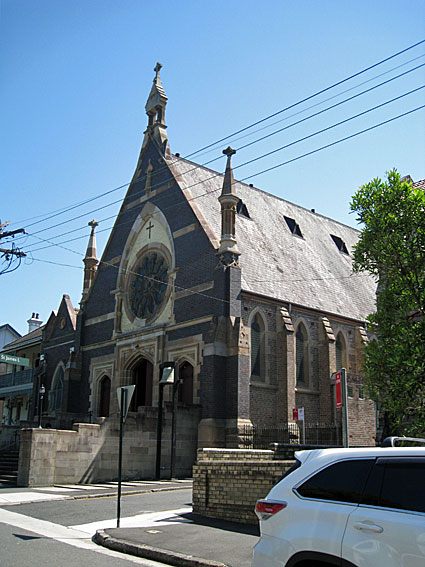
St James' Catholic Church, Forest Lodge
[Photograph by Geoffrey Cox (November 2016)]

St James' Catholic Church, Forest Lodge
[Photograph by Geoffrey Cox (November 2016)]
Historical and Technical Documentation by Geoffrey Cox
© OHTA 2016 (last updated November 2016)
The foundation stone of St James' Church was laid on 7 July 1877, and the church was formally opened by Archbishop Vaughan on 1 September 1878. Designed by the architect, John Kirkpatrick, it was built in Venetian Gothic style of Prymont stone and New Zealand kauri pine.1 The stained glass was supplied by Falconer & Ashwin.2
First Organ.
There was reportedly 'a handsome organ' in St James' Church, presented by Miss FitzStubbs, in time for the opening of the building in September 1878.3 This was presumably the 'cabinet organ' mentioned in the following account from The Freeman's Journal in August 1883, when a second-hand pipe organ, known to have been built by Charles J. Jackson of Sydney, was opened at St James':
ORGAN OPENING, ST. JAMES'S, FOREST LODGE.
It was only the proper thing for the people of the Forest Lodge parish to mark in some special manner the erection and "opening" of the new organ of which they are the fortunate possessors. The instrument is not exactly new, but it is a good one, and in admirable order; and what is perhaps better than all, it was purchased for the church at a figure that, to use a trade term, may be said to be ridiculously low. For such a church as St. James's a better instrument could scarcely have been obtained anywhere, for it is amply sufficient in power, besides being beautifully sweet in tone. The whole amount spent in the purchase of the organ and its erection does not exceed £100, and for their money the parishioners have some thing that they may regard with a pardonable pride. On Sunday last the organ was played for the first time. Missa Cantata was sung by the Rev. H. B. Callachor, pastor, and the Rev. A. T. O'Dwyer, of St. Joseph's, New Town, was the preacher. As regards the musical service, it must be confessed, that although some of the singing reached a high standard of excellence, the music altogether was less effective than on those special "music days" which have been noticed from time to time in these columns. In sopranos and basses the choir was undoubtedly strong, but in other respects there was an apparent weakness: indeed there was no leading tenor of any description, and this last defect sadly interfered with the success of the concerted parts. Then again Mrs. Hemsleigh the lady organist, who is so accomplished and brilliant a pianiste, and who gave so much satisfaction by her playing on the now discarded cabinet organ, had not the instrument completely under her command, and therefore was not able to give the singers the help they required, especially in the heavy and trying choruses. Mrs. F. Kiley, of St. Mary's Cathedral choir, was the leader on this occasion, and this lady, with Mrs. W. M'Donald, worked ably and loyally from first to last. Signor Bartolomeotti conducted, and the solo singers besides the two ladies already mentioned were Miss Larter, Mr. T. H. Rainford, and Mr. M. J. Fitzpatrick. Among those whose services were of particular value were Miss Hayes, Mrs. T. H. Rainford, Miss Carey, Mr. Wenban, Mr. Callinan, Mr. Downing, Mr. Driscoll, Mr. M'Namara, and Mr. S. F. Scott. Mr. Fitzpatrick sang the Prayers before Mass with much impressiveness of style, and then the most popular of all Kyries, Mozart's, was commenced. The Gloria was also from No. 12, and the remaining portions of the Mass were selected from Haydn's Imperial, and his second mass. During the Offertory Mrs. Riley, whose singing is always devotional, and for that reason admirable, sang with perfect finish and expression, an 'Ave Maria' by Carmusci ; a composition surpassing in sweetness, and excelling in beauty of sentiment, the 'Salve Regina' of the same composer, which is sung often in our city choirs. After the Sanctus, Mrs. M'Donald gave a splendid rendering of an "O Salutaris" set to one of Pinsuittis' songs, her rich, powerful voice ringing through the church, and producing a great effect. After Mass Mr. Rainford sang the celebrated "Sanctum et Terribile." The general arrangements in the choir were, we understand, in the hands of Mr. S. F. Scott. . . .
The organ is a one manual instrument from CC to G in alto with a full compass of pedals from CCC to F ; thirty notes also separate pedal pipes. Two composition pedals, i.e., to take the stops in or out without taking the hands off the keys. The whole enclosed in a general swell. The following is the list of stops and number of pipes:-
Stops.
1. Bourdon
2. Open diapason
3. Stopt diapason
4. Principal
5. Wa[l]d flute
6. Twelfth
7. Fifteenth
Pedal Organ.
8. Bourdon
9. Couple pedals to keys.
... 16 wood
... 8 metal
... 8 wood
... 4 metal
... 4 wood
... 3 metal
... 2 metal
... 16 wood
... 56
... 56
... 56
... 56
... 56
... 56
... 56
... 30
The instrument was originally built by Mr. Jackson, of Newtown, and it has been re-erected by Mr. Baker, of Forest Lodge.4
The Jackson organ was traded in when the present organ was installed, and later sold by W.H. Paling & Co. of Sydney to St Stephen's Anglican Church, Bellevue Hill.5
Present Organ.
The present organ was built for W.H. Paling & Co. Ltd, Sydney, by Whitehouse Bros of Brisbane, apparently as a joint business venture. The Whitehouse ledger entry, dated 15 December 1933, describes it simply as '1 Electro-pneumatic Pipe Organ as per Spec'. The total cost was £1,041.4.10, and the final payment was dated March 1934.6 The so-called 'Paling-Whitehouse' organ was advertised in The Methodist in January 1934 (6 January 1934), p. 4, as being on display at Palings, 338 George Street, Sydney.7

Advertisement for the 'Paling-Whitehouse' organ
in The Methodist (6 January 1934), reproduced in
Graeme Rushworth, Historic Organs of New South Wales (1988), p. 206.
This instrument was one of several 'extension organs' built by Whitehouse Bros from 1932 onwards, others being at Holy Rosary Catholic Church, Bundaberg (1932), St Andrew's Presbyterian Church, Bundaberg (1933), the Presbyterian Church, Ithaca (1933), St Patrick's Catholic Cathedral, Toowoomba (1935), the New England Girls' School, Armidale (1936) and the Church of England Grammar School, East Brisbane (1942).
A later Whitehouse Bros list confirms that the instrument built for W.H. Paling & Co. is now at St James', Forest Lodge.8 The 'Paling-Whitehouse' organ was purchased by St James' Church in the early months of Fr. P.A. Doherty's time there, which began in July 1935. The purchase was the result of a bequest by the former organist, Miss Hogan.9
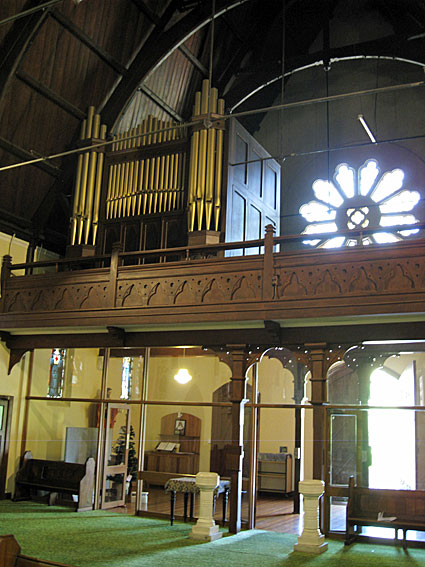
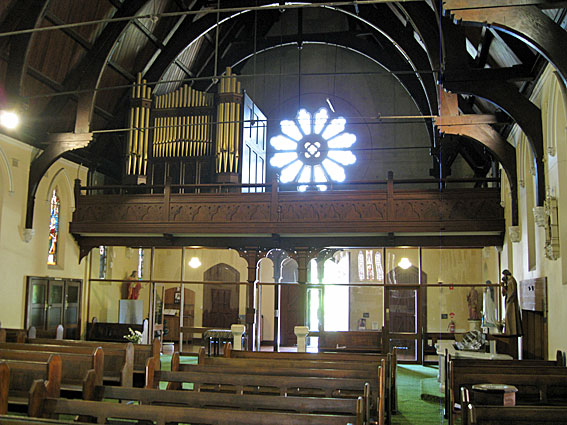
The organ located in the gallery
[Photographs by Geoffrey Cox (November 2016)]
The organ is located on one side of the gallery over the West door. The casework, comprising two towers with decorative braces and a central flat with transom rail, was standard to many Whitehouse organs of the late 1920s and early 1930s, including those at St Andrew's Presbyterian Church, Inverell (1927), St Paul's Presbyterian, Armidale (1929), St Andrew's Presbyterian, Chatswood (1930), the Presbyterian Church, Ithaca (1933), and St Patrick's Catholic Cathedral, Toowoomba (1934).

The detached roll-top console at floor level in the nave
[Photograph by Geoffrey Cox (November 2016)]
The detached roll-top console, imported from Aug. Laukhuff, is also a standard Whitehouse type that can be observed at the Methodist Church, Chatswood (1930), Holy Rosary Church, Bundaberg (1932), St Patrick's Catholic Cathedral, Toowoomba (1935), the New England Girls' School, Armidale (1936) and later at St James' Kelvin Grove (1959) and St Ignatius, Toowong (1959). It is now situated downstairs on the left-hand side of the nave towards the sanctuary, but until around 1978 was on the opposite side of the nave, facing the altar.10 It may possibly originally have been in the gallery.
The specification comprises 5 ranks extended, with an independent Mixture II on the Swell, added by Pitchford & Garside of Sydney in the early 1970s using pipework and a new chest supplied by George Fincham & Sons of Melbourne. The organ was refurbished around 1996 by Pitchford & Garside, at which time the bellows were re-leathered and new stop-keys and a solid-state switching system by Kimber Allen UK were installed.11
With individual ranks serving all pitch levels (apart from the independent Sub Bass 16ft on the pedals), the pipework is very successfully scaled for extension. The independence of the Pedal Sub Bass 16ft rank, which was presumably made by Whitehouse Bros in Brisbane, can also be observed at the Presbyterian Church, Ithaca (1933) and at St Patrick's Catholic Cathedral, Toowoomba (1935).
GREAT |
8 8 8 4 4 2-2/3 2 8 8 8 4 4 2-2/3 2 II rks 8 16 8 8 4 4 8 4 |
A B C A B A A D B C B C B B [early 1970s] D A B A B D D |
General tremulant
Oboe tremulant
3 thumb pistons to Swell
3 thumb pistons to Great
Electro-pneumatic action
Detached console
Balanced swell pedal
Compass: 61/30
Pedalboard: radiating & concave.12
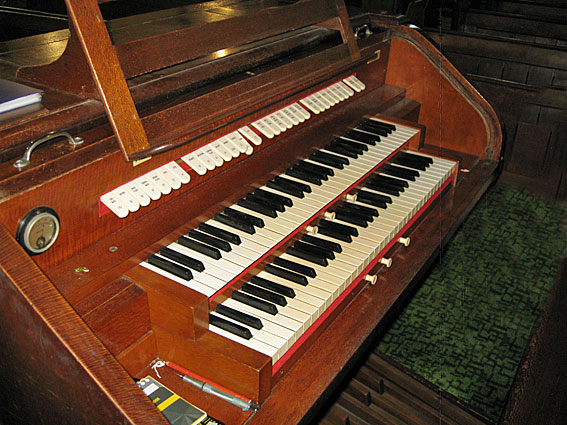
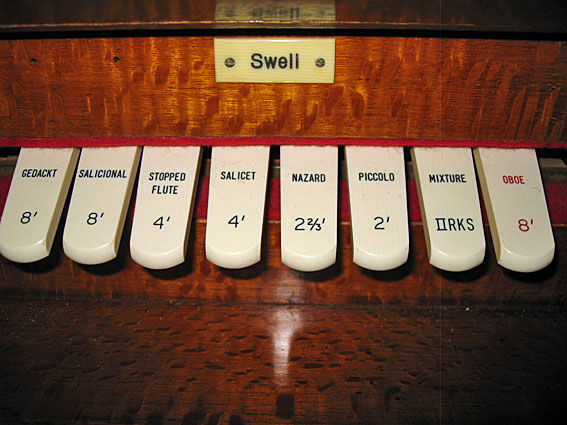
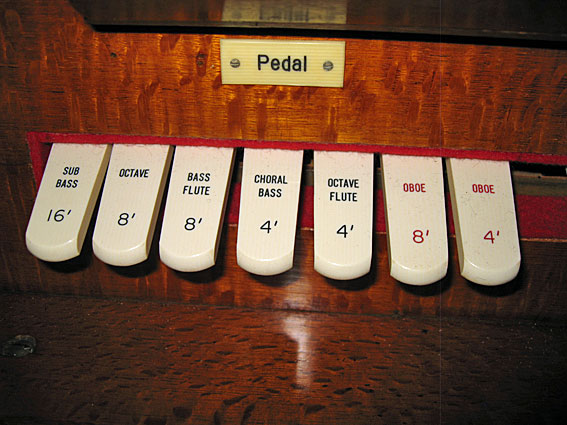
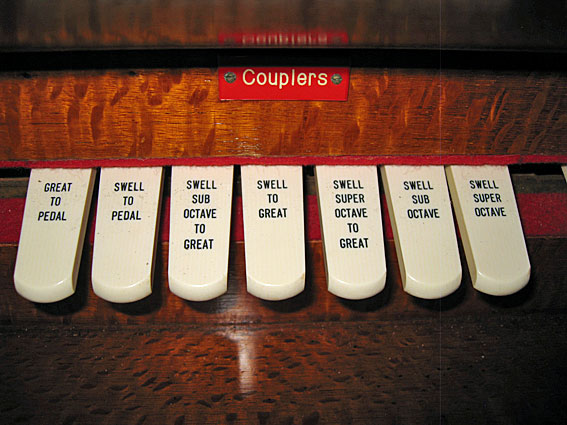
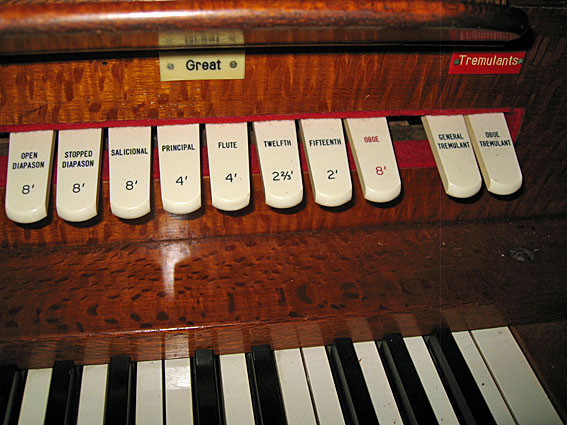
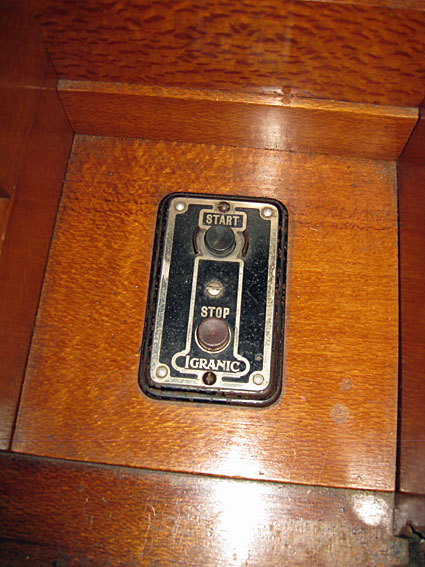
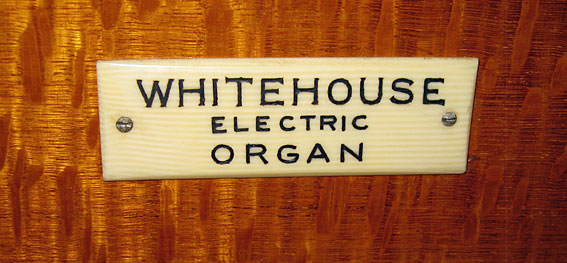
Console details
[Photographs by Geoffrey Cox ( November 2016)]
1 John Fletcher & Michael Hogan, 'St James' Church, Forest Lodge: a chronicle of parish life (1877-2002),' MS in Mitchell Library; cited February 2013 at http://www.thomasjfletcher.com/StJamesHistory.html
2 Graeme Rushworth, A Supplement to Historic Organs of New South Wales: The Instruments, Their Makers and Players, 1791-1940 (Camberwell, Organ Historical Trust of Australia, 2006), p. 42.
3 Fletcher & Hogan, op. cit.
4 The Freeman's Journal (4 August 1883), p. 18; reference cited in Graeme Rushworth, Historic Organs of New South Wales: The Instruments, Their Makers and Players, 1791-1940 (Sydney: Hale & Iremonger, 1988), pp. 98, 444.
5 Rushworth, A Supplement (2006), op. cit, p. 42.
6 Whitehouse Bros Ledger (1922-1940), p. 307.
7 The Methodist (6 January 1934), p. 4; cited in Rushworth, Historic Organs (1988), op. cit., pp. 206, 431.
8 Described as 'Whitehouse List 2' in: Geoffrey Cox, 'Whitehouse Trackers: Reviewing the Opus List and Re-writing History,' OHTA News, vol. 35, no. 4 (October 2011), pp. 24-31.
9 Fletcher & Hogan, op. cit.
10 Personal communication to G. Cox from Darrell Pitchford, November 2016.
11 Personal communication to G. Cox from Darrell Pitchford, November 2016.
12 Specification noted by Geoffrey Cox, November 2016. The nomenclature may not be original.